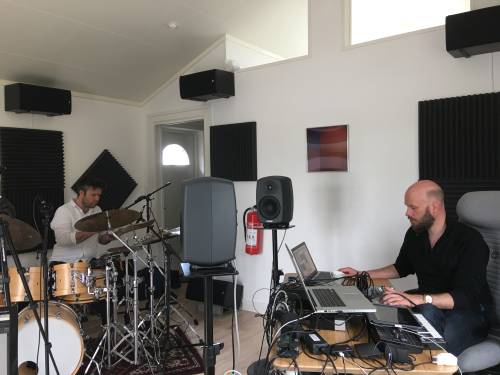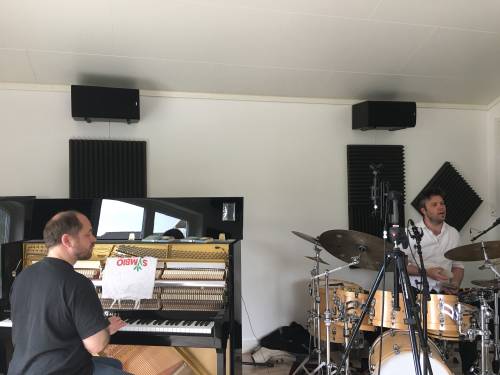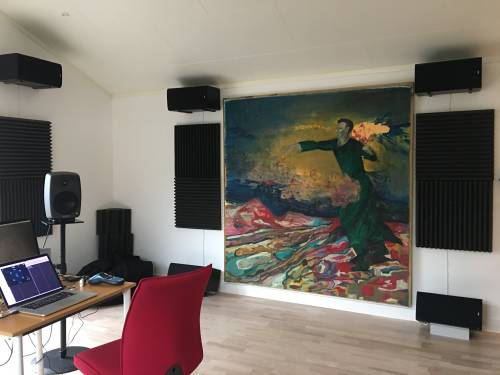Table of Contents
This page provides additional information for the piece written for His Voice.
Trond Lossius: building real and calculated places for spatial sound art.
1. The new studio.
The value of a studio as a tool for thinking in space first dawned on my when I became an artistic research fellow at Bergen Academy of the Arts back in 2003. I got a fantastic workspace of more than 30 m2 as my office space. I was working with spatial audio in installations, and rather than using standard speaker layouts I tended to come up with site-specific idiosyncratic speaker layouts. Although the exhibition spaces would differ from the studio, I experimented extensively with speaker configurations, spatialisation techniques and a general testing out and experimenting with sound in space, reconfiguring the studio on a monthly basis. I just loved it.
When I finished the artistic fellowship I wanted to continue this studio-based practise, but renting a space is expensive, so I ended up in a smaller office space. It was still useful as a hide-away for focused work, but no longer offered the same possibilities for trying out ideas in space. Additionally it was far enough away from home and my workplace at BEK - Bergen Centre for Electronic Arts, that the distance limited how much I managed to make use of it.
My wife suggested that I should instead build an annex behind our house to use as studio, and last fall we sat down and started making the drawings. We had help building it, which went quickly, and two months ago I moved in.
The space has two rooms: A storage room of approx 12 m2 and a main studio space of approx 27 m2, being an almost perfect square. In recent years I have done a lot of work with Ambisonics, and the dimensions of the studio are good for these kind of surrounding layouts. Doors and windows give indirect daylight but no sun. The space resembles a small white cube, and the plywood walls means that I can easily mount stuff on the walls as needed, and modify and hack the space depending on the need of ongoing projects.
On the walls I have acoustic treatments. They are installed so that it’s easy to take it down and e.g. paint or project on the walls. So far I also have two images installed: A lenticular print on PETG plastic by Brian Eno (I got this from my siblings last year as a present) and a large painting by my friend Apichaya Wanthiang. She was here earlier today helping me to frame and install the painting. In the near future I hope to have one more up, from another artist friend of mine. The good thing about listening at length is that it also gives me time to look, and I look forward to living with these images over extended periods of time.
2. The infrastructure.
In recent years I have experimented extensively with ambisonics, not least in the project The Atmospherics, an ongoing series of installations of sound and video in collaboration with my friend Jeremy Welsh, based on field trips and audio-visual field recordings exploring places and the sense of place. The studio is currently set up with a 16 B&W 602 speaker ambisonic rig similar to what have used in our installations: A ring of 8 speakers near the floor and another 8 speakers near the ceiling. In addition I have a pair of higher-quality studio monitors that I can use for more detailed sound design.
When i’m alone at the studio, I have a small desk set up in the middel of the room so that I can work and listen at the sweet spot. Bit when others come in to work with me, this can be reorganised. Last week I had the Jazz improv trio Pd Conception coming in to work with me. I moved to a corner, and then we filled up the rest of the space with a piano, drum kit and a desk for laptop improvisation. Later this week I’ll clear parts of the space in order to work with video projections in preparation for another upcoming project, part of an artistic research project at Norwegian Theatre Academy.
3. The works.
I’ll using the studio when preparing new works and installations, but I will also use it as a laboratory, to do experiments, fool around, test stuff out and gain and accumulate experiences. I feel that I have really good listening conditions here, when working in stereo as well as when working in surround. An important part of the process when working with surround sound is to just listen - listen - listen. Many spatial processes are delicate and nuanced, and it takes time for myself to learn to listen for them, attune my ear, and validate if what I theoretically think happens is also what I actually hear.
For several years I have been exploring the use of first order ambisonic field recordings. This is a many-layered material with many layers being researched in parallell. It is a listening to places and the world, and an engagement with the aural sociogeography of the kind of places that I mostly engage with - the soundscapes of suburbs. IT is also a listening to the listening itself, and a discovery of the spatial and placial information embedded in surrounding sound, and our auditory capacity for interpreting spatial sound. There are a number of technical issues that I’m researching, mostly relating to audio engineering, and in particular how to develop an agile workflow for editing and composing with ambisonic sound fields, and how to adapt and extend audio engineering mixing principles beyond stereo. From a compositional perspective I’m addressing issues of how to use these field recordings, and how they might be used as is or be processed, abstracted and treated as musical and compositional material. How can this be done, and what can it mean artistically? The sound artist Stuart Fowkes that is running the Cities and Memory project (http://citiesandmemory.com/) talks about “reimagining” places when field recordings get processed, abstracted and developed or transformed into music. What can this be, and how and can it be done? I’ll be experimenting with my own material in situations when I don’t have the pressure of having to produce results immediately for upcoming installations, but rather can explore at a slower speed that gives ample time to listening and reflecting. Listening to the works by other sound artists and composers is also an important part of this process.
I recently did a one day sound installation based on compositions and sound recordings by the late Morten Eide Pedersen. He was my composition teacher at the Grieg Academy, and was a very important resource for organisations, composers, musicians and every one else that engaged with contemporary and experimental music in Bergen and beyond. For this installation I reimagined works of his, and it was the first that I was able to develop at the new studio. I’ve invested in the Sonarworx speaker calibration system, and was able to do acoustic measurements of what my speakers sound like in the room, and correct for artefacts introduced by speakers and space. This gives much better and neutral fidelity in playback. When I was setting up the actual installation, I had very little time on site, maybe only 6 hours. I did the same calibration and correction there. The result was that material developed at the studio was easily recognisable in the installation space. I have always struggled with adapting material to installation sites, and have depended on working at the site for several days to develop and adjust sound material. This time around material was much more portable, and this was critical for achieving the artistic results that I aimed for. I guess this is the first new “find” that I have made after the studio was finalised.
Over the next year I have several new projects coming up. I have a commission from NOTAM for a 3rd order ambisonic composition. This will be developed at my studio and during residencies in the Sirius studio at NOTAM. I also have a commission for a new work with te fee jazz/electronica trio Pd Conception. Last week we had an initial 3 day session at my studio, combining field recordings, piano, percussion and laptop electronics. Coming weekend I’ll be working with Karen Kiphoff on video material for an upcoming performance. Being able to adjust and reconfigure the studio depending on what’s needed is a great asset for these kind of processes.
But before I can do that I have to finalise my tax reports tomorrow. That’s the more dull kind of work that the studio is also to be used for. But as little as possible!








